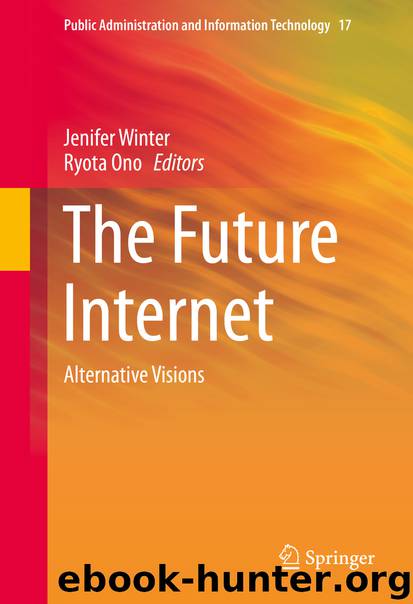The Future Internet by Jenifer Winter & Ryota Ono

Author:Jenifer Winter & Ryota Ono
Language: eng
Format: epub
Publisher: Springer International Publishing, Cham
Affect has become a popular concept in theoretical circles as it points toward our inherent plasticity as “porously open systems” (Dator et al. 2015, p. 3). As Hemmings explains, “[Affect] is transferred to others and doubles back, increasing its original intensity. Affect can thus be said to place the individual in a circuit of feeling and response…” (Hemmings 2005, p. 552). In challenging the hegemony of agency, affect suggests a host of social and political implications —the most profound of which is that our brains and bodies are so highly susceptible to a range of epigenetic forces that the very categories used to designate individuality—in many places, the basis for rights and citizenship—are, at best, ambiguous, if not entirely arbitrary. In our all-too-modern world, this plasticity is integral as a cause and effect of infectious connectivity. For many, infectious connectivity is the nagging impulse to check your e-mail; the desire to click the refresh button on your social media feed when you have just loaded the page; the frustration of tossing and turning at night only to be comforted by the soft illumination of a familiar screen. For others, infectious connectivity is what happened to Marge Fitzsimmons; the neurosomatic impulse to live away from the modern world; the push of a digital future, the weight of an all-too-human past, or something in-between that can and might shape what lies just over the horizon. Infectious connectivity, then, is affect incarnate—the trans-situational context for our all-too-human bodies engaging with “mutative” media in the extended present and a range of alternative futures (Dator et al. 2015).
Can affect explain the outbreak in Le Roy? Does the WWW have the capacity to infect someone? Could infectious connectivity be exploited or perhaps even weaponized? While some scenarios for the future of the Internet focus on e-health (Burns and McGrail 2012) and many more entertain a host of possibilities on cybersecurity (Burns and McGrail 2012; Creech et al. 2009; Rueda‐Sabater and Derosby 2011), few, if any, confront the implications of infectious connectivity, even though such interests have become a focus for those seeking to profit from our all-too-permeable humanity. As Sampson reports, “Infectable emotions, feelings, and affects have in effect become the favored focal point for experience designers and neuromarketers” (Sampson 2012, p. 32). From the Facebook-approved, yet covert, experiment on users’ emotions (Kramer et al. 2014; Meyer 2014) to the advent of Internet fasting camps in Japan (Samakow 2013), the affective impact of the WWW has never been more felt.
Using the lens of Postnormal Times to investigate the WWW’s infectious connectivity, this study deploys a new foresight method to explore the emerging forces and issues pushing and weighing the WWW in the years to come. Developed in 2010 by Sardar, the concept of Postnormal Times argues that we inhabit “an in-between period where old orthodoxies are dying, new ones have yet to be born, and very few things seem to make sense” (Sardar 2010, p. 435). This global phenomenon is experienced in highly localized ways and
Download
This site does not store any files on its server. We only index and link to content provided by other sites. Please contact the content providers to delete copyright contents if any and email us, we'll remove relevant links or contents immediately.
Embedded Programming with Modern C++ Cookbook by Igor Viarheichyk(4093)
Linux Device Driver Development Cookbook by Rodolfo Giometti(4022)
Implementing Cellular IoT Solutions for Digital Transformation by Dennis McCain(4011)
Embedded Linux Development Using Yocto Project - Third Edition by Otavio Salvador & Daiane Angolini(3870)
TinyML Cookbook by Gian Marco Iodice(3775)
Simplifying 3D Printing with OpenSCAD by Colin Dow(2906)
TinyML Cookbook by Gian Marco Iodice & Ronan Naughton(2659)
Fusion 360 for Makers by Lydia Sloan Cline(2308)
Networking A Beginner's Guide by Bruce Hallberg(2290)
Hands-On Linux for Architects by Denis Salamanca(2132)
Computers For Seniors For Dummies by Nancy C. Muir(2106)
But How Do It Know? by J. Clark Scott(2079)
Raspberry Pi and MQTT Essentials by Dhairya Parikh(2040)
Arduino Project Handbook, Volume 2: 25 Simple Electronics Projects for Beginners by Geddes Mark(1999)
9781803246888-ENHANCING DEEP LEARNING WITH BAYESIAN INFERENCE by Unknown(1971)
Hack and HHVM by Owen Yamauchi(1956)
31 Days Before Your CompTIA A+ Exams (Shanette Luellen's Library) by Benjamin Patrick Conry(1925)
Hands-On Internet of Things with MQTT by Tim Pulver(1828)
MicroPython Projects by Jacob Beningo(1820)
